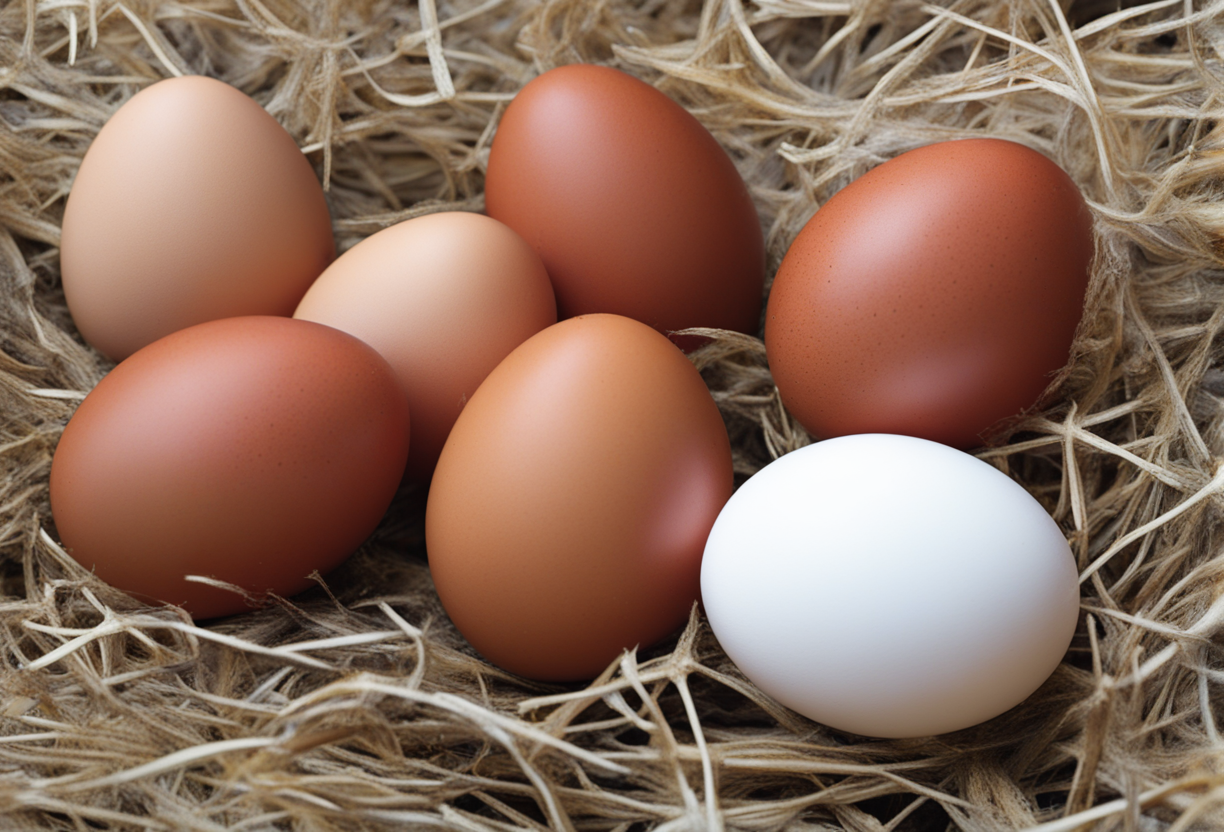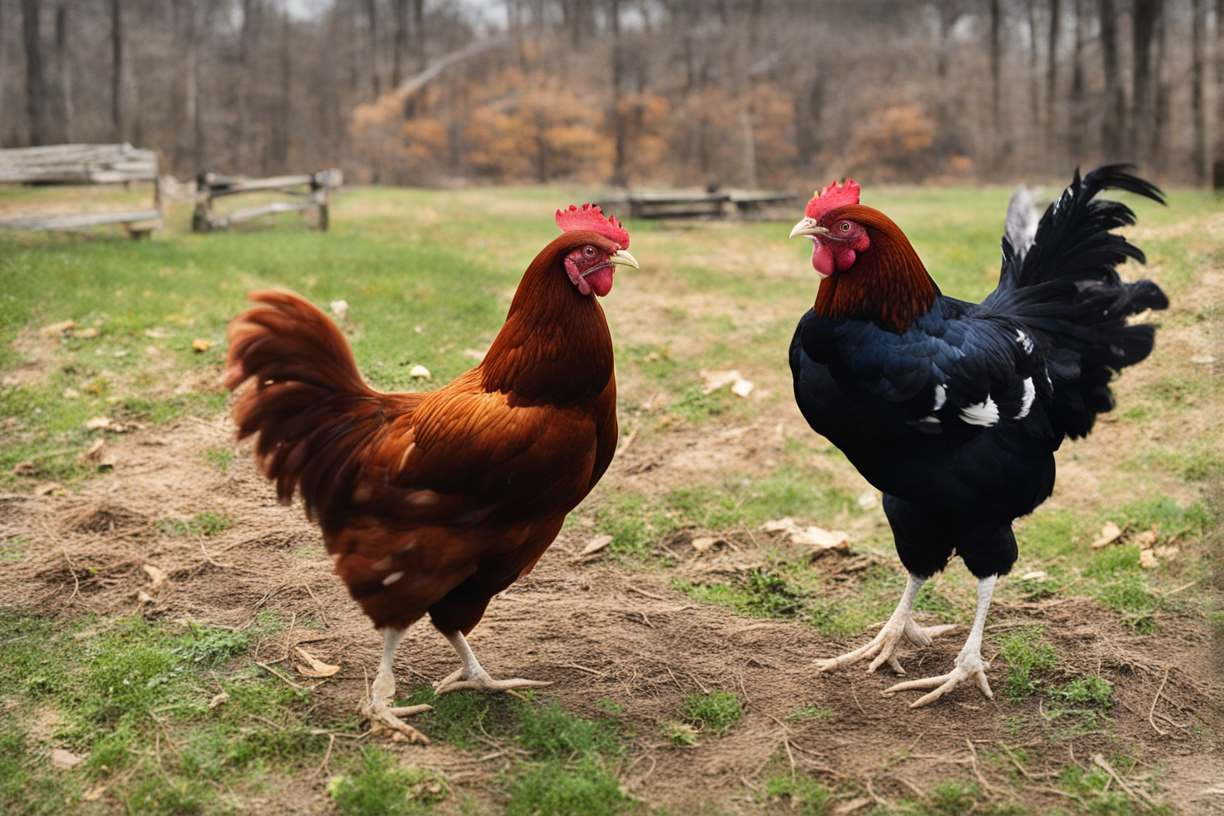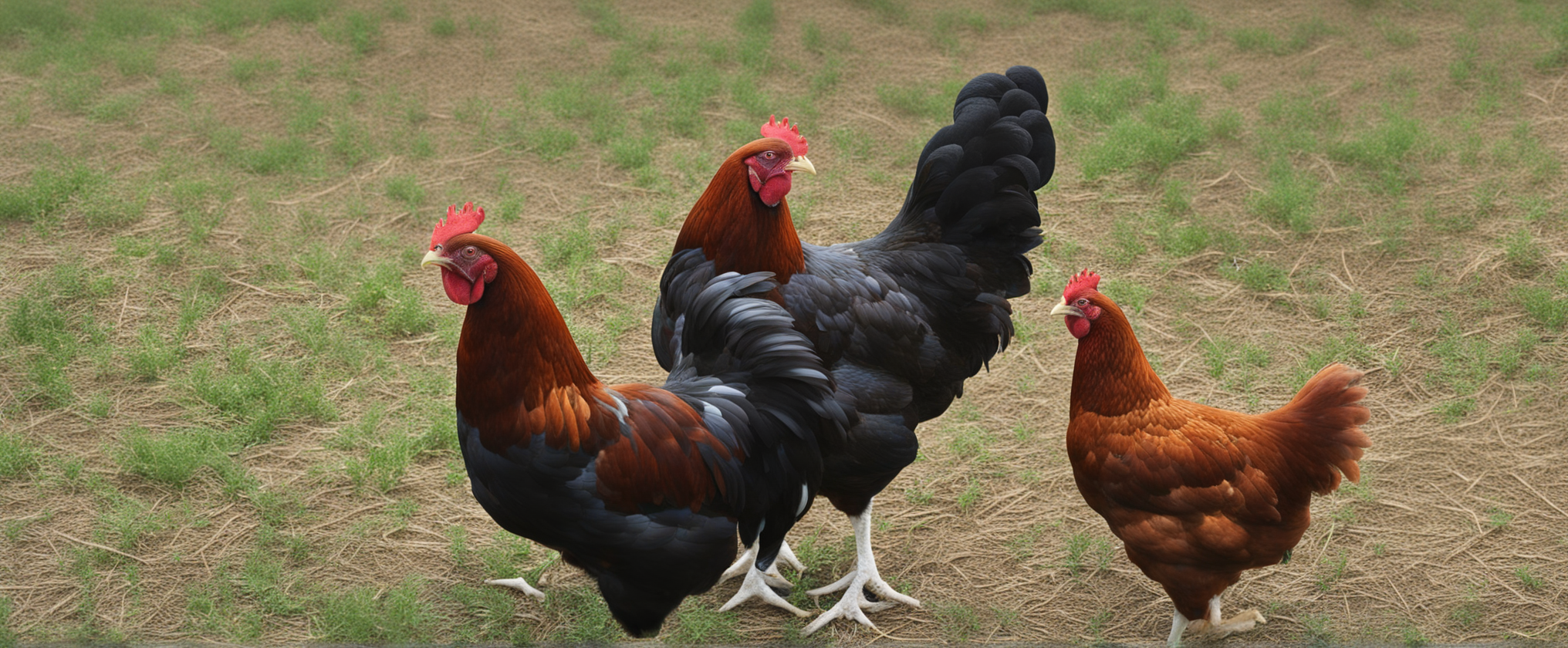As a backyard chicken keeper for over 5 years, I’m often asked which breed I recommend for eggs and meat.
My top picks are always Rhode Island Reds and Australorps.
But which one is really the best? Let’s break it down in this post.
For maximum egg production year after year, go with Rhode Island Reds.
If you want a dual-purpose bird that excels at both eggs and meat, choose Australorps.
Now, I wasn’t always a chicken expert.
When I first got into keeping chickens, I made some hilarious rookie mistakes.
Like the time I bought a rooster from the feed store thinking it was a hen! Boy, was I surprised when that little guy started crowing at dawn.
Let’s just say the neighbors weren’t too happy with my natural alarm clock.
After a few angry phone calls, I quickly re-homed him to a nearby farm.
Table of Contents
Egg Laying
When it comes to pumping out eggs year after year, Rhode Island Reds are the undisputed champs. We’re talking 250-300 large brown eggs per year consistently!

They start laying early at around 5 months old and will keep popping out 4-5 eggs per week well into their second year of lay.
In my experience, the Rhode Island Red hens I’ve raised have never gone broody. This makes them ideal if you want maximum egg production. I had one stalwart hen who never missed a beat, laying an egg almost every day for 3 years straight!
Australorps are also excellent layers but they will go broody more often. A broody hen stops laying and sits on a nest full time trying to hatch eggs.
Each broody bout will lower your total egg numbers for the year. Australorps will lay roughly 250 light brown eggs annually if not allowed to go broody.
The other advantage Rhode Island Reds have is early maturity. Their egg production will really ramp up at 5-6 months old, a good few weeks earlier than Australorps. So if you want maximum eggs in year one, go with the Rhode Island Reds.
Meat Production
Here’s where the Australorps shine above other laying breeds. Roosters regularly grow to 8-9 lbs dressed weight by 5-6 months old. And hens easily reach 6-8 lbs dressed weight, making them the ideal dual-purpose bird.

Rhode Island Reds don’t have quite the meaty build of Australorps. Their dressed weight averages around 5-6 lbs for hens at 6 months. And roosters range from 7-8 lbs dressed. That’s 2-3 lbs less than Australorps of the same age.
I raised a small batch of RIR roosters one season and processed them at 5 months old. They averaged 6 lbs dressed weight – decent for stews but much lighter than the Australorps. If you want birds that pull double duty for both meat and eggs, go with the Australorps.
Temperament
In my long experience raising both breeds, Rhode Island Reds and Australorps have outstanding temperaments. Neither breed is aggressive and they are quite docile and friendly.
Rhode Island Reds tend to be slightly more active foragers when let out to free range. Australorps are a bit more laidback and content to lazily graze near their coop or in the run.

With gentle handling from a young age, both breeds can be picked up and held without issue. I’ve found the Australorp hens to be especially mellow. Even my broodiest mamas allow me to reach in and gather eggs without fuss.
Overall both Reds and Australorps make fantastic backyard chickens for families and first-time owners.
Their calm temperament means they are great for children’s 4H projects or just as family pets. As long as you handle them regularly as chicks, they’ll be friendly and docile throughout their laying years.
Climate Tolerance
Here in Texas, heat tolerance is a big factor when choosing a chicken breed. Luckily, both Rhode Island Reds and Australorps hold up well in hot, humid climates without issues.
Their large single combs and fairly sparse feathering allows for good heat dissipation in summer. I’ve raised them for years through 100+ degree summer heat waves without any problems.
However, that same large comb can make them prone to frostbit in colder northern winters. If you live in areas with temperatures below 20 degrees F, be sure to use cold-hardy breeds with smaller combs like Wyandottes, Orpingtons or Chanteclers.
In moderate and warm climates, both Reds and Australorps will thrive and lay straight through the hot summer months. Their heat-hardy genetics make them ideal for southern flocks.
Appearance
Rhode Island Reds have that classic farmyard chicken look. Roosters sport long sickle feathers, a single comb, and lustrous reddish-orange plumage. Hens are a slightly duller shade of mahogany brown all over.
Australorps are flashy black chickens with a beautiful beetle green sheen that glistens in the sun. Their feathers shimmer an iridescent purple-green when hit with direct light. Solid black plumage and a single comb gives them an elegant silhouette.

Both breeds have yellow skin and legs. Reds lay large light brown eggs while Australorps lay even lighter brown eggs. The Australorp eggs can appear almost tinted pink when held up to light.
If you’re looking to add some beautiful colored birds to your flock, you can’t go wrong with either breed. The striking red and black will make your chickens stand out from their free range neighbors!
Feeding
Both Rhode Island Reds and Australorps are excellent foragers when allowed to free range. They will eagerly hunt for bugs, seeds and greens if given the chance. This helps supplement their diet and reduces feed costs.
However, they still need a complete 16-18% protein feed available at all times. I recommend an organic layer feed for optimal nutrition. Make sure the feed does not contain meat bone meal, animal fat or other low quality ingredients.
Supplement their diet with table scraps, chopped fruits and vegetables. Squash, melon, tomatoes, and leafy greens are favorites. Just introduce new treats slowly to avoid upset digestion.
Oyster shell or limestone grit should also be available free choice to provide calcium for strong eggshells. And they need clean, fresh water at all times – chickens drink a surprising amount!
In winter when forage is scarce, increase their feed ration to account for less natural food intake. Australorps may need slightly more feed as they are bigger, meatier birds. But both breeds are efficient and don’t gorge themselves when feed is abundant.
Avoid overfeeding as excess weight can affect egg production. An overweight hen puts energy into making fat instead of eggs. Ideal body condition is lean and muscular while still rounded.
Make sure feed and water is kept clean and prevent it from getting wet or moldy. Place feeders under cover to keep contents dry in rain. Rotating multiple feeders allows you to take them out of service for thorough cleaning.
With quality feed and supplemental forage, both Rhode Island Reds and Australorps will stay in peak health and lay at their maximum genetic potential.
Housing
Rhode Island Reds and Australorps are both cold hardy down to around 10 degrees Fahrenheit. While they can handle some cold, it’s important to protect them from winter drafts and moisture.
The coop should have tightly sealed exterior walls with good insulation like straw bales. Install roosts that allow at least 12 inches of space per bird – they huddle close for warmth.
Deep litter beds of wood shavings, straw or rice hulls will also generate beneficial heat and naturally compost inside the coop.
Ventilation is still important even in cold months to reduce ammonia build up. Leave eave vents open along with windows cracked for fresh air flow.
Heating the coop is usually unnecessary unless you live far north. Chickens can comfortably tolerate freezing overnight lows. Just make sure they stay dry and out of drafts.
In summer, good ventilation keeps them from overheating. Australorps may be slightly more heat tolerant thanks to their Australian origins. But Reds also thrive in warm climates when shaded.
Free range birds will stay cooler as they find shade under trees and bushes. A simple sheet metal awning over their outdoor run creates shade and allows breezes.
Space per bird inside the coop should be at least 2-3 square feet each. Crowding leads to bullying, injuries and poor cleanliness. Small flocks under a dozen do fine in simple coops of around 50-100 square feet.
Whether you build a coop or buy one pre-made, be sure to make it predator proof. Use sturdy hardware cloth under the run and coop floor to prevent digging by predators.
Broodiness
One consideration between Rhode Island Reds and Australorps is their tendency toward broodiness. Broody hens stop laying and sit on a nest full time trying to hatch eggs.
Rhode Island Reds rarely go broody. It’s unusual to find a hen that will consistently try to set a clutch and hatch chicks. This makes them the ultimate egg production breed.
Australorps are known for being moderately broody. It’s not uncommon for a hen to vanish from the coop into a secret nest location. After gathering a clutch, she’ll hunker down and refuse to leave for 21 days.
If you don’t want broody hens, immediately remove them from the nest and isolate in a wire bottom cage called a “broody breaker”. This prevents her from sitting and she will stop being broody within a few days.
To allow a hen to hatch chicks, set her up in a separate nursery coop safe from predators. Provide feed and water she can access from the nest. Expect chicks to hatch after 21 days of diligent incubation.
Broody Australorp hens make excellent mothers and will fiercely defend their chicks. Rhode Island Reds rarely make successful broody hens. If you want a hen to raise chicks for you, go with the Australorps.
Even non-broody hens of both breeds can be used to hatch fertile eggs. Just pop the eggs under them on the nest at night and many will get the mothering instinct.
In summary, prolific egg layers avoid broodiness so Rhode Island Reds are the better pure production breed. Australorps are superior for natural incubation thanks to their broody tendencies.
Breeding and Chicks
Both Rhode Island Reds and Australorps are easy to breed and make great parents. Always keep the ratio at least 10 hens per rooster, otherwise the girls get stressed and overmated.
Before putting a rooster in with hens, get him fixed with poultry saddle bands. These prevent him from actually mating while still allowing normal breeding behaviors.
Collect eggs daily for eating to ensure they are fresh. If you skip a day of egg collection, fertility shoots up as the eggs sit in the nest!
To hatch chicks, remove the saddle bands and save eggs for 7-10 days before putting them in an incubator or under a broody hen.
Candle the eggs at one week to check for viable embryos. Clear the non-fertiles and any quitters who died off early. This leaves the strongest to hatch.
Incubate eggs at 99.5F and 60% humidity for 21 days. Provide ventilation but avoid drafts which can chill the eggs. Turn the eggs 3-5 times per day to prevent sticking.
Make sure to track hen’s ID and date each egg for hatching records. Pedigree breeding requires stringent tracking for generations.
Day old chicks need a brooder with dry bedding and 100F heat for the first week. Drop 5 degrees per week until fully feathered when heat can be removed.
Feed chicks a 20% protein starter crumble with extra oyster shell. Consider probiotics and electrolytes in their water for the first few days.
After 4-6 weeks in the brooder, they can join the adult flock. Expect pullets to start laying around 16-20 weeks of age depending on breed and season.
Predator Protection
Free ranging chickens face threats from aerial and ground predators. Skunks, opossums, raccoons and foxes will all kill and eat chickens.
Secure small openings with hardware cloth so no predators can dig into the run or coop. Bury fencing 6 inches or more to stop digging.
Use hot wire or rolled fence tops to keep climbing predators like raccoons out of the run. Clip bird wings or fully enclose the run with netting for protection.
Lock birds in the coop at night for safety. Automatic doors open at dawn to let them out – do not free range at night.
Hawks, eagles and owls can all occasionally take chickens in daytime. Have shelters, bushes or shrubs for them to quickly take cover.
Guard animals like dogs, donkeys and llamas provide security if bonded to the chickens. Just supervise interactions cautiously.
Live traps baited with cat food or bacon can catch moles, rats, skunks and opossums for removal. Be sure to check traps frequently before they expire.
Discourage aerial attacks by tying loose strings across the run area. Vary lengths and heights – predators avoid these entanglements.
Motion-activated sprinklers effectively deter nocturnal prowlers. The sudden water burst frightens them away.
Ultimately a secure coop and run is the best defense. Close them in each night and do regular perimeter checks for any openings or weaknesses.
With good housing and care, Rhode Island Reds and Australorps will reward you with years of bountiful eggs.
Rhode Island Red and Australorp in a Feathered Face-Off
| Rhode Island Red | Australorp | |
|---|---|---|
| Egg Production | 250-300 eggs per year | 250 eggs per year |
| Egg Color | Brown | Light brown |
| Temperament | Active, docile | Calm, friendly |
| Heat Tolerance | Excellent | Excellent |
| Cold Hardiness | Moderate | Moderate |
| Rooster Weight | 7-8 lbs | 8-9 lbs |
| Hen Weight | 5-6 lbs | 6-8 lbs |
| Dual Purpose | No | Yes |
| Broodiness | Rarely Broody | Moderately Broody |
| Egg Laying Onset | 5 months | 6 months |
| Plumage Color | Red/orange | Black with green sheen |
| Comb Type | Single comb | Single comb |
| Climate Tolerance | Warm climates | Warm climates |
| Temperament | Active, docile | Calm, friendly |
| Predator Avoidance | Moderate | Moderate |
| Foraging Ability | Excellent | Moderate |
| Coop Size Needed | 2-3 sq ft per bird | 2-3 sq ft per bird |
| Cost | $-$$ | $-$$ |
| Docile with Handling | Yes | Yes |
| Beginner Friendly | Yes | Yes |
| Ideal Diet | Layer feed + forage | Layer feed + forage |
Let’s recap the key differences between these two outstanding heritage breeds:
- Rhode Island Reds are the champion egg layers, averaging 5-6 eggs a week
- Australorps excel at both meat and eggs but lay slightly fewer eggs annually
- Reds start laying earlier at 5 months vs. 6 months for Australorps
- Both are very heat hardy and suitable for southern flocks
- Gentle temperament and friendliness make them great family chickens
- Rhode Island Reds have classic red and orange plumage
- Australorps dazzle in black with beautiful green iridescence
